Pumping Station Desing - Second Edition by Robert L. Sanks, George Tchobahoglous, Garr M. Jones
Подождите немного. Документ загружается.

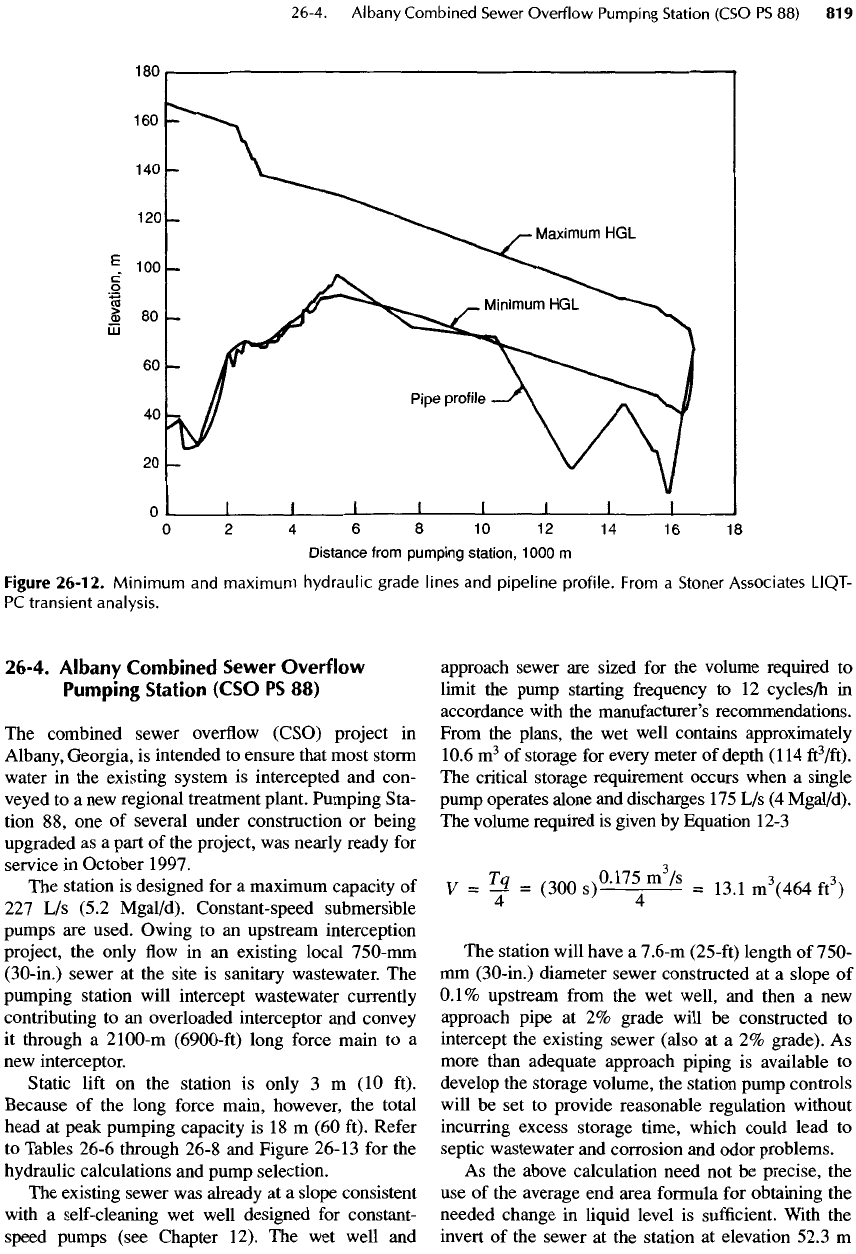
26-4.
Albany
Combined
Sewer
Overflow
Pumping
Station
(CSO
PS 88)
The
combined sewer
overflow
(CSO) project
in
Albany,
Georgia,
is
intended
to
ensure that most storm
water
in the
existing system
is
intercepted
and
con-
veyed
to a new
regional treatment plant. Pumping Sta-
tion
88, one of
several under construction
or
being
upgraded
as a
part
of the
project,
was
nearly ready
for
service
in
October
1997.
The
station
is
designed
for a
maximum capacity
of
227
L/s
(5.2
Mgal/d).
Constant-speed submersible
pumps
are
used. Owing
to an
upstream interception
project,
the
only
flow in an
existing local
750-mm
(30-in.)
sewer
at the
site
is
sanitary wastewater.
The
pumping station will
intercept
wastewater currently
contributing
to an
overloaded interceptor
and
convey
it
through
a
2100-m
(6900-ft)
long force main
to a
new
interceptor.
Static
lift
on the
station
is
only
3 m (10
ft).
Because
of the
long force main, however,
the
total
head
at
peak pumping capacity
is 18 m (60
ft).
Refer
to
Tables 26-6 through 26-8
and
Figure 26-13
for the
hydraulic
calculations
and
pump selection.
The
existing sewer
was
already
at a
slope consistent
with
a
self-cleaning
wet
well designed
for
constant-
speed pumps
(see
Chapter
12).
The wet
well
and
approach sewer
are
sized
for the
volume required
to
limit
the
pump starting
frequency
to 12
cycles/h
in
accordance with
the
manufacturer's recommendations.
From
the
plans,
the wet
well contains approximately
10.6
m
3
of
storage
for
every meter
of
depth
(1
14
ft
3
/ft).
The
critical
storage
requirement occurs when
a
single
pump
operates alone
and
discharges
175
L/s (4
Mgal/d).
The
volume required
is
given
by
Equation 12-3
V
-
T
*
~
(300
s)
ai75
4
m3/S
=
13.1
m
3
(464ft
3
)
The
station will have
a
7.6-m
(25-ft)
length
of
750-
mm
(30-in.) diameter sewer constructed
at a
slope
of
0.1% upstream
from
the wet
well,
and
then
a new
approach pipe
at 2%
grade will
be
constructed
to
intercept
the
existing sewer (also
at a 2%
grade).
As
more than adequate approach piping
is
available
to
develop
the
storage volume,
the
station pump controls
will
be set to
provide reasonable regulation without
incurring excess storage time, which could lead
to
septic
wastewater
and
corrosion
and
odor
problems.
As
the
above calculation need
not be
precise,
the
use of the
average
end
area formula
for
obtaining
the
needed change
in
liquid level
is
sufficient.
With
the
invert
of the
sewer
at the
station
at
elevation 52.3
m
Figure
26-12.
Minimum
and
maximum
hydraulic
grade lines
and
pipeline
profile.
From
a
Stoner Associates LIQT-
PC
transient analysis.
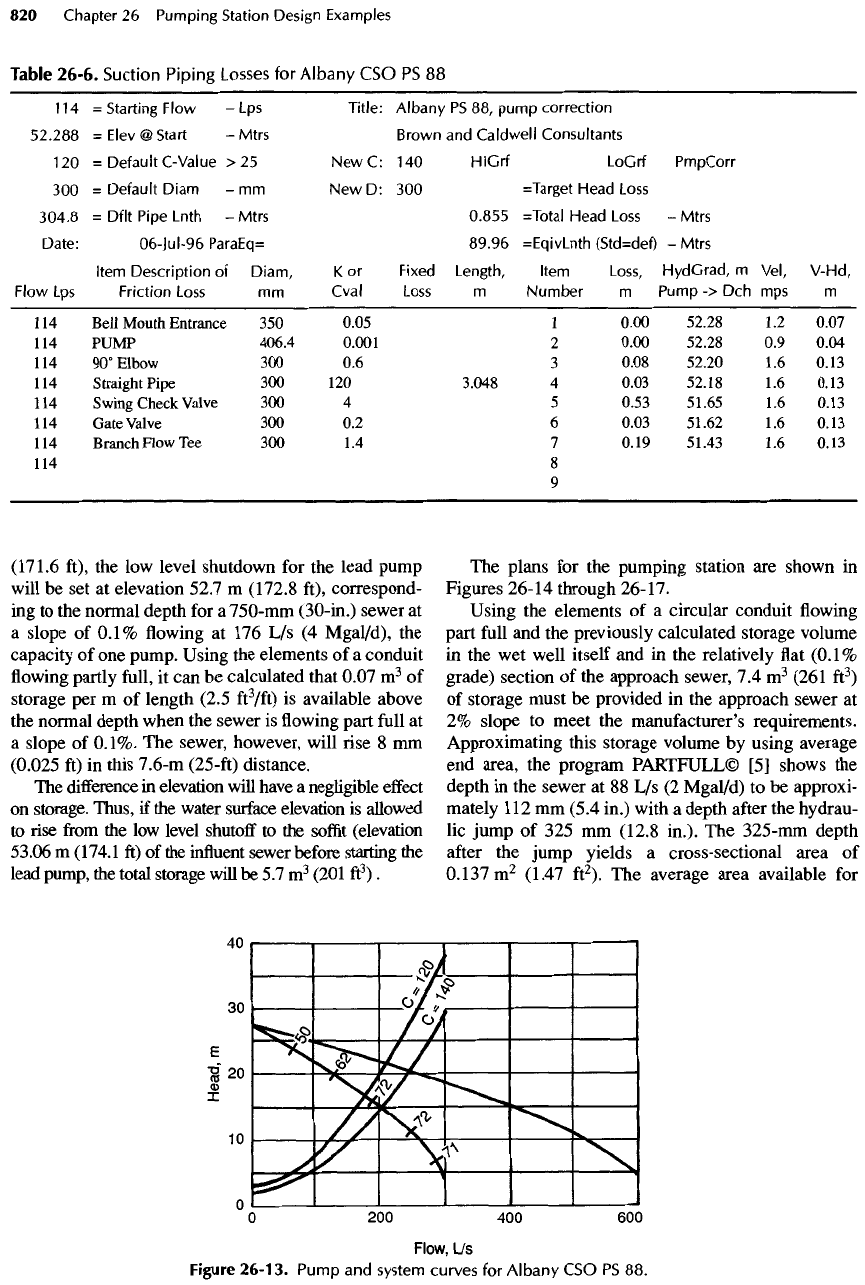
(171.6
ft),
the low
level shutdown
for the
lead pump
will
be set at
elevation 52.7
m
(172.8 ft), correspond-
ing
to the
normal depth
for a
750-mm
(30-in.)
sewer
at
a
slope
of
0.1%
flowing at 176 L/s (4
Mgal/d),
the
capacity
of one
pump. Using
the
elements
of a
conduit
flowing
partly
full,
it can be
calculated that 0.07
m
3
of
storage
per m of
length (2.5
ft
3
/ft)
is
available above
the
normal depth when
the
sewer
is flowing
part
full
at
a
slope
of
0.1%.
The
sewer, however, will
rise
8 mm
(0.025
ft) in
this 7.6-m
(25-ft)
distance.
The
difference
in
elevation will have
a
negligible
effect
on
storage. Thus,
if the
water
surface
elevation
is
allowed
to
rise
from the low
level
shutoff
to the
soffit
(elevation
53.06
m
(174.1
ft) of the
influent
sewer
before
starting
the
lead
pump,
the
total storage will
be 5.7
m
3
(201
ft
3
)
.
The
plans
for the
pumping station
are
shown
in
Figures
26-14
through
26-17.
Using
the
elements
of a
circular conduit
flowing
part
full
and the
previously calculated storage volume
in
the wet
well itself
and in the
relatively
flat
(0.1%
grade) section
of the
approach sewer,
7.4
m
3
(261
ft
3
)
of
storage must
be
provided
in the
approach sewer
at
2%
slope
to
meet
the
manufacturer's requirements.
Approximating this storage volume
by
using average
end
area,
the
program
PARTFULL©
[5]
shows
the
depth
in the
sewer
at 88 L/s (2
Mgal/d)
to be
approxi-
mately
112
mm
(5.4 in.) with
a
depth
after
the
hydrau-
lic
jump
of 325 mm
(12.8
in.).
The
325-mm depth
after
the
jump yields
a
cross-sectional area
of
0.137m
2
(1.47
ft
2
).
The
average area available
for
Table
26-6.
Suction
Piping
Losses
for
Albany
CSO PS 88
114
=
Starting Flow
- Lps
Title:
Albany
PS
88,
pump
correction
52.288
=Elev@
Start
-
Mtrs
Brown
and
Caldwell
Consultants
120
=
Default
C-VaIue
> 25
New
C: 140
HiGrf
LoGrf PmpCorr
300
=
Default
Diam
- mm New D: 300
=Target Head
Loss
304.8
=
DfIt
Pipe Lnth
-
Mtrs 0.855 =Total Head
Loss
-
Mtrs
Date: 06-Jul-96
ParaEq=
89.96 =EqivLnth (Std=def)
-
Mtrs
Item Description
of
Diam,
K or
Fixed
Length,
Item
Loss,
HydGrad,
m
VeI, V-Hd,
Flow
Lps
Friction
Loss
mm
Cval
Loss
m
Number
m
Pump
-> Dch mps m
114
Bell Mouth Entrance
350
0.05
1
0.00 52.28
1.2
0.07
114
PUMP 406.4 0.001
2
0.00 52.28
0.9
0.04
114
9O
0
EIbOW
300 0.6 3
0.08 52.20
1.6
0.13
114
Straight Pipe
300 120
3.048
4
0.03 52.18
1.6
0.13
114
Swing Check
Valve
300 4 5
0.53 51.65
1.6
0.13
114
Gate
Valve
300 0.2 6
0.03 51.62
1.6
0.13
114
Branch Flow
Tee 300 1.4 7
0.19 51.43
1.6
0.13
114
8
9
Figure
26-13.
Pump
and
system curves
for
Albany
CSO PS 88.
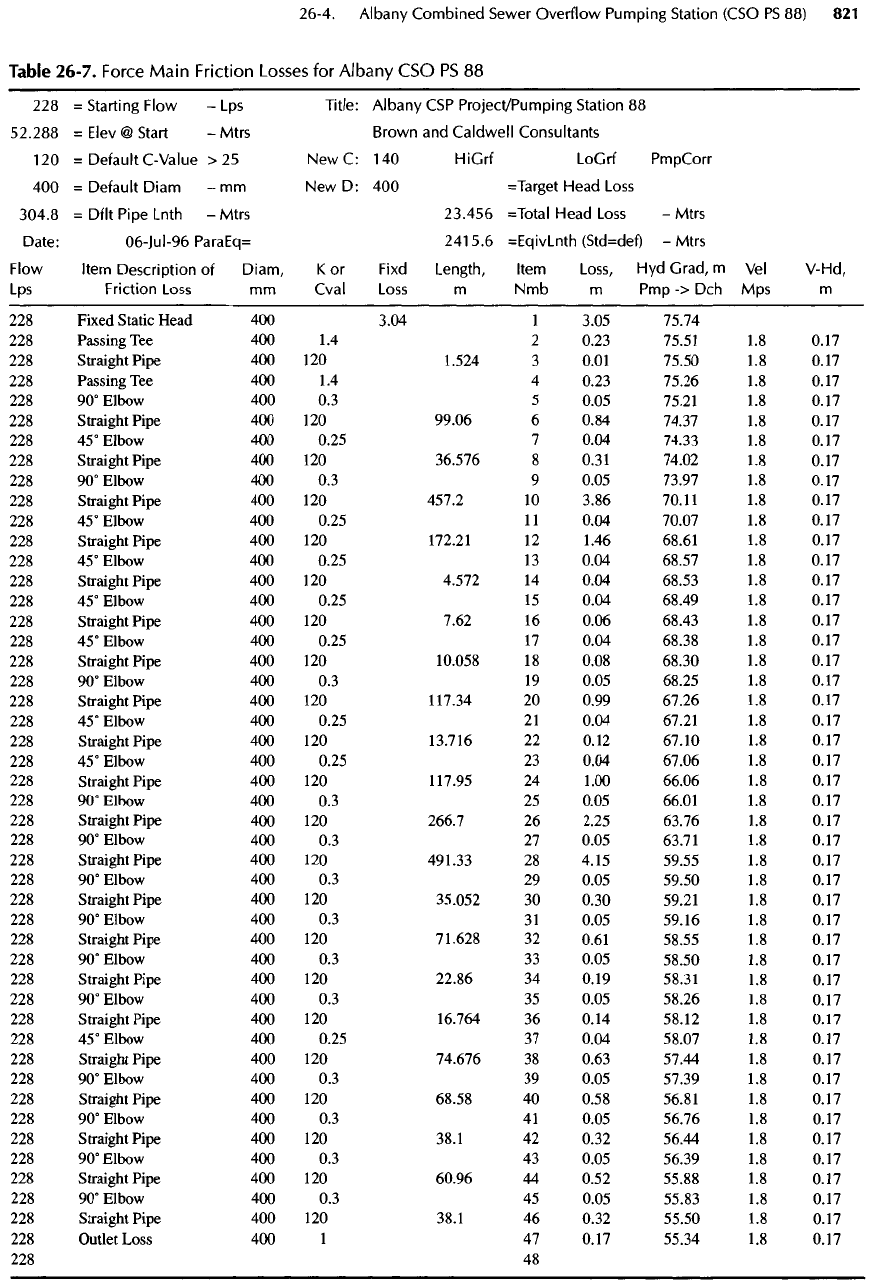
Table
26-7.
Force
Main
Friction
Losses
for
Albany
CSO PS 88
228
=
Starting Flow
- Lps
Title: Albany
CSP
Project/Pumping
Station
88
52.288
=
Elev
@
Start
-
Mtrs Brown
and
Caldwell
Consultants
120
=
Default
C-Value
>
25 New C:
140
HiGrf
LoGrf
PmpCorr
400
=
Default Diam
- mm New D: 400
=Target Head
Loss
304.8
=
DfIt
Pipe Lnth
-
Mtrs 23.456
=Total
Head
Loss
-
Mtrs
Date: 06-Jul-96
ParaEq=
2415.6 =EqivLnth
(Std=def)
-Mtrs
Flow
Item Description
of
Diam,
K or
Fixd
Length,
Item
Loss,
Hyd
Grad,
m VeI
V-Hd,
Lps
Friction
Loss
mm
Cval
Loss
m
Nmb
m
Pmp
-> Dch Mps m
228
Fixed Static Head
400
3.04
1
3.05
75.74
228
Passing
Tee 400 1.4 2
0.23 75.51
1.8
0.17
228
Straight Pipe
400 120
1.524
3
0.01
75.50
1.8
0.17
228
Passing
Tee 400 1.4 4
0.23
75.26
1.8
0.17
228
9O
0
EIbOw
400 0.3 5
0.05 75.21
1.8
0.17
228
Straight Pipe
400 120
99.06
6
0.84
74.37
1.8
0.17
228
45°Elbow
400
0.25
7
0.04
74.33
1.8
0.17
228
Straight Pipe
400 120
36.576
8
0.31
74.02
1.8
0.17
228
9O
0
EIbOw
400 0.3 9
0.05
73.97
1.8
0.17
228
Straight Pipe
400 120
457.2
10
3.86 70.11
1.8
0.17
228
45°Elbow
400
0.25
11
0.04
70.07
1.8
0.17
228
Straight Pipe
400 120
172.21
12
1.46 68.61
1.8
0.17
228
45°Elbow
400
0.25
13
0.04
68.57
1.8
0.17
228
Straight Pipe
400 120
4.572
14
0.04
68.53
1.8
0.17
228
45°Elbow
400
0.25
15
0.04
68.49
1.8
0.17
228
Straight Pipe
400 120
7.62
16
0.06
68.43
1.8
0.17
228
45°Elbow
400
0.25
17
0.04
68.38
1.8
0.17
228
Straight Pipe
400 120
10.058
18
0.08
68.30
1.8
0.17
228
9O
0
EIbOw
400 0.3 19
0.05
68.25
1.8
0.17
228
Straight Pipe
400 120
117.34
20
0.99
67.26
1.8
0.17
228
45°Elbow
400
0.25
21
0.04 67.21
1.8
0.17
228
Straight Pipe
400 120
13.716
22
0.12 67.10
1.8
0.17
228
45°Elbow
400
0.25
23
0.04
67.06
1.8
0.17
228
Straight Pipe
400 120
117.95
24
1.00
66.06
1.8
0.17
228
90°Elbow
400 0.3 25
0.05 66.01
1.8
0.17
228
Straight Pipe
400 120
266.7
26
2.25
63.76
1.8
0.17
228
90°Elbow
400 0.3 27
0.05 63.71
1.8
0.17
228
Straight Pipe
400 120
491.33
28
4.15
59.55
1.8
0.17
228
90°Elbow
400 0.3 29
0.05
59.50
1.8
0.17
228
Straight Pipe
400 120
35.052
30
0.30
59.21
1.8
0.17
228
90°Elbow
400 0.3 31
0.05 59.16
1.8
0.17
228
Straight Pipe
400 120
71.628
32
0.61
58.55
1.8
0.17
228
9O
0
EIbOW
400 0.3 33
0.05
58.50
1.8
0.17
228
Straight Pipe
400 120
22.86
34
0.19 58.31
1.8
0.17
228
9O
0
EIbOW
400 0.3 35
0.05
58.26
.8
0.17
228
Straight Pipe
400 120
16.764
36
0.14 58.12
.8
0.17
228
45°Elbow
400
0.25
37
0.04
58.07
.8
0.17
228
Straight Pipe
400 120
74.676
38
0.63
57.44
.8
0.17
228
9O
0
EIbOW
400 0.3 39
0.05
57.39
.8
0.17
228
Straight Pipe
400 120
68.58
40
0.58 56.81
.8
0.17
228
90°Elbow
400 0.3 41
0.05
56.76
.8
0.17
228
Straight Pipe
400 120
38.1
42
0.32
56.44
.8
0.17
228
9O
0
EIbOw
400 0.3 43
0.05
56.39
.8
0.17
228
Straight Pipe
400 120
60.96
44
0.52
55.88
.8
0.17
228
90°Elbow
400 0.3 45
0.05
55.83
.8
0.17
228
Straight Pipe
400 120
38.1
46
0.32
55.50
.8
0.17
228
Outlet Loss
400 1 47
0.17
55.34
.8
0.17
228
48
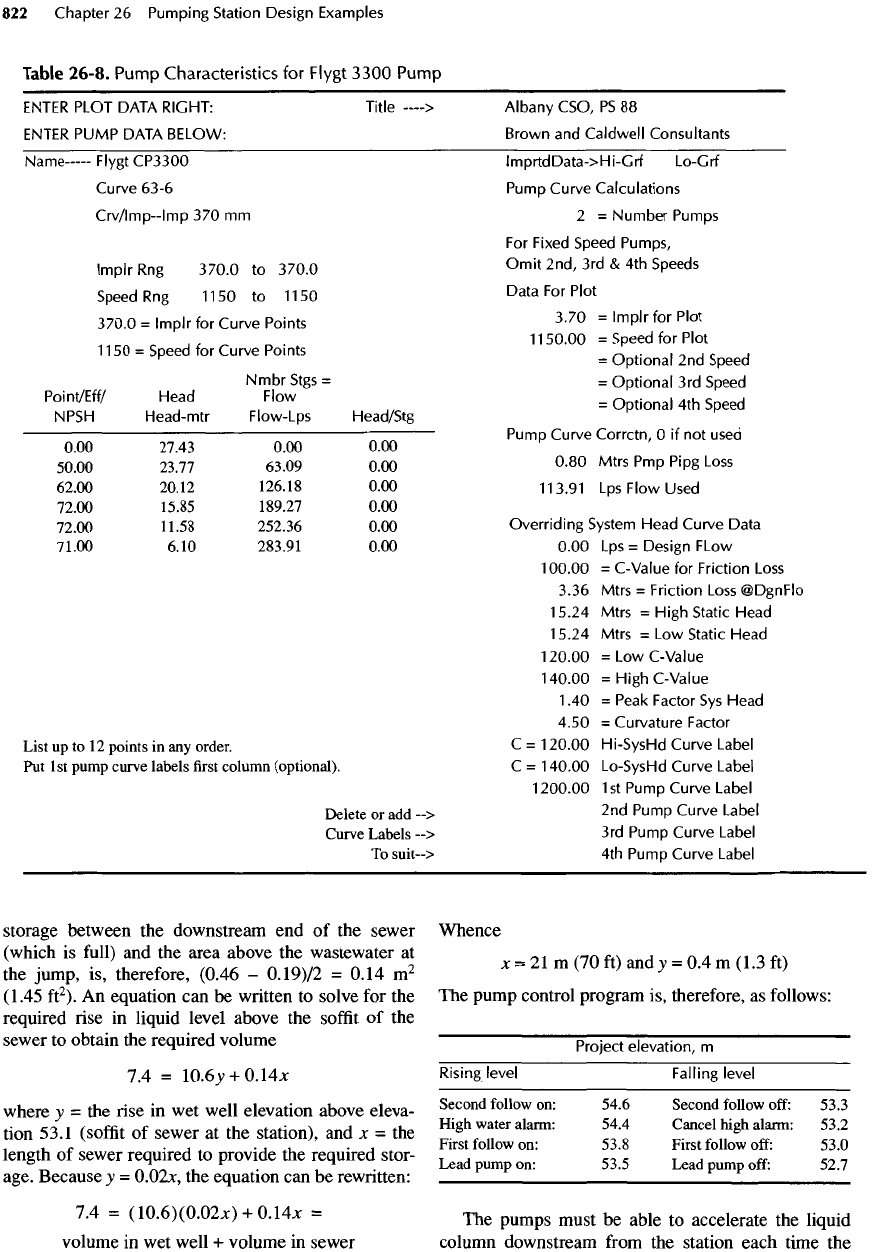
storage
between
the
downstream
end of the
sewer
(which
is
full)
and the
area above
the
wastewater
at
the
jump,
is,
therefore, (0.46
-
0.19)/2
=
0.14
m
2
(1.45
ft
2
).
An
equation
can be
written
to
solve
for the
required
rise in
liquid level above
the
soffit
of the
sewer
to
obtain
the
required volume
7.4 =
10.6V
+
0.14*
where
y = the rise in wet
well elevation above eleva-
tion
53.1
(soffit
of
sewer
at the
station),
and x = the
length
of
sewer required
to
provide
the
required stor-
age. Because
y =
0.02x,
the
equation
can be
rewritten:
7.4 =
(10.6)(0.02*)
+
0.14jc
=
volume
in wet
well
+
volume
in
sewer
Whence
x = 21 m (70 ft) and y = 0.4 m
(1.3
ft)
The
pump control program
is,
therefore,
as
follows:
Project
elevation,
m
Rising
level
Falling
level
Second
follow
on:
54.6
Second
follow
off:
53.3
High
water
alarm:
54.4
Cancel
high
alarm:
53.2
First
follow
on:
53.8
First
follow off:
53.0
Lead
pump
on:
53.5
Lead
pump off:
52.7
The
pumps must
be
able
to
accelerate
the
liquid
column
downstream
from
the
station each time
the
Table
26-8.
Pump
Characteristics
for
Flygt
3300
Pump
ENTER
PLOT DATA RIGHT: Title
—>
Albany
CSO,
PS 88
ENTER
PUMP DATA BELOW: Brown
and
Caldwell
Consultants
Name
Flygt
CP3300
lmprtdData->Hi-Grf
Lo-Grf
Curve
63-6 Pump Curve Calculations
Crv/lmp—Imp
370 mm 2 =
Number
Pumps
For
Fixed Speed Pumps,
ImplrRng 370.0
to
370.0
Omit
2nd,
3rd & 4th
Speeds
Speed
Rng
1150
to
1150
Data
For
Plot
370.0
=
lmplr
for
Curve Points
3
-
70
=
lmplr
for
Plot
1150.00
=
Speed
for
Plot
1150
=
Speed
for
Curve Points
*~
.
.
„
,
„
=
Optional
2nd
Speed
Nmbr
Stgs
=
=
Optional
3rd
Speed
Point/Eff/
Head Flow
=
NPSH
Head-mtr
Flow-Lps
Head/Stg
p
H
Pump
Curve Corrctn,
O if not
used
0.00 27.43
0.00 0.00
H
50.00 23.77 63.09
0.00
°-
80
Mtrs
Pmp
Pipg
Loss
62.00
20.12
126.18
0.00
113.91
Lps
Flow Used
72.00
15.85
189.27
0.00
72.00
11.58
252.36
0.00
Overriding
System
Head Curve Data
71.00
6.10
283.91
0.00 0.00
Lps
=
Design FLow
100.00
=
C-Value
for
Friction
Loss
3.36
Mtrs
=
Friction
Loss
@DgnFlo
15.24
Mtrs
=
High
Static
Head
15.24
Mtrs
= Low
Static Head
120.00
= Low
C-Value
140.00
=HighC-Value
1.40
=
Peak
Factor
Sys
Head
4.50
=
Curvature Factor
List
up to 12
points
in any
order.
C =
120.00
Hi-SysHd Curve Label
Put 1st
pump
curve
labels
first
column
(optional).
C =
140.00
Lo-SysHd Curve Label
1200.00
1 st
Pump Curve Label
Delete
or add -->
2nd
Rum
P
Curve Label
Curve
Labels
--> 3rd
Pump Curve Label
To
suit~>
4th
Pump Curve Label
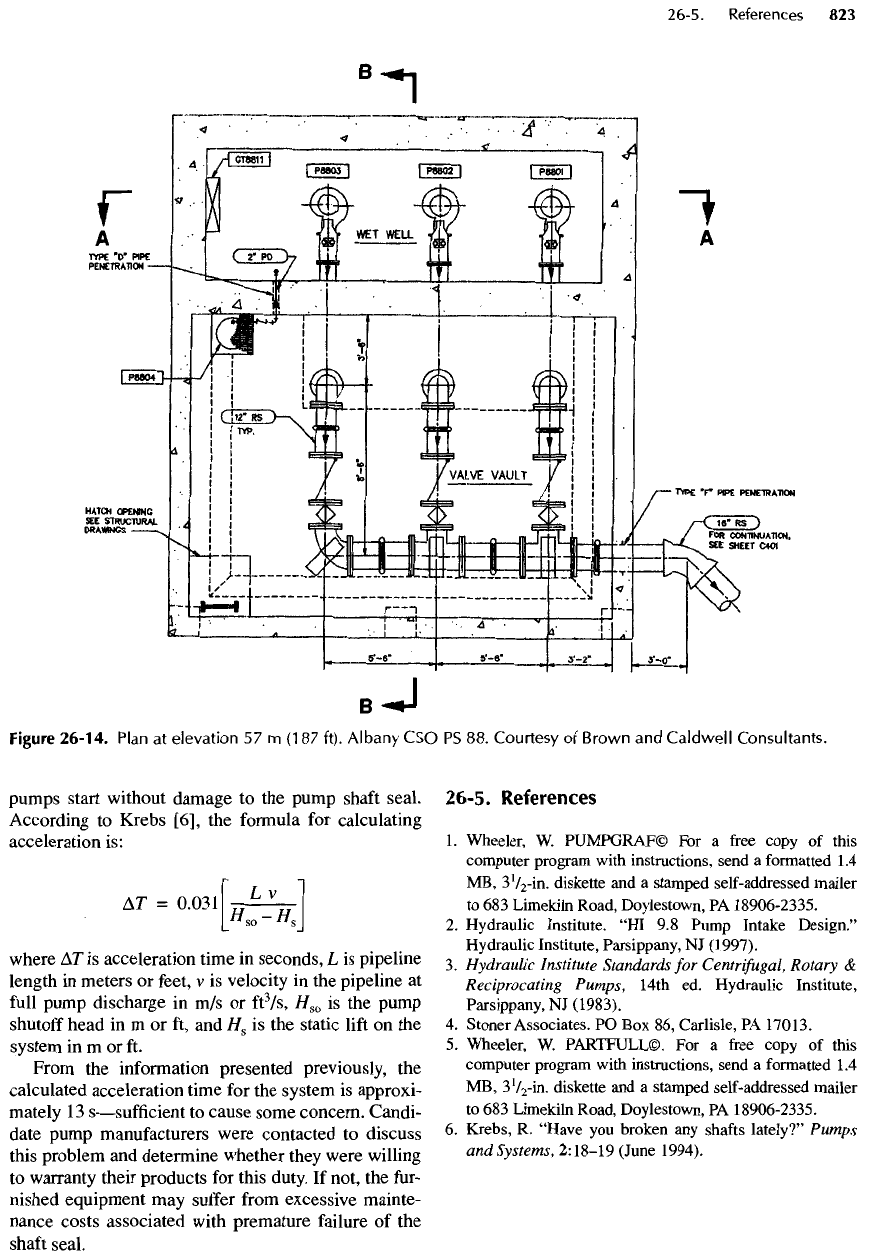
pumps
start without damage
to the
pump
shaft
seal.
According
to
Krebs [6],
the
formula
for
calculating
acceleration
is:
-
-
•»»'[»:-».]
where
AT
is
acceleration time
in
seconds,
L is
pipeline
length
in
meters
or
feet,
v is
velocity
in the
pipeline
at
full
pump discharge
in m/s or
ft
3
/s,
H
80
is the
pump
shutoff
head
in m or ft, and
H
s
is the
static
lift
on the
system
in m or ft.
From
the
information presented previously,
the
calculated acceleration time
for the
system
is
approxi-
mately
13
s
—
sufficient
to
cause some concern. Candi-
date pump manufacturers were contacted
to
discuss
this
problem
and
determine whether they were willing
to
warranty their products
for
this duty.
If
not,
the
fur-
nished
equipment
may
suffer
from
excessive mainte-
nance
costs associated with premature
failure
of the
shaft
seal.
26-5.
References
1.
Wheeler,
W.
PUMPGRAF©
For a
free
copy
of
this
computer program with instructions, send
a
formatted
1.4
MB,
3
1
J
2
-M.
diskette
and a
stamped self-addressed mailer
to 683
Limekiln Road, Doylestown,
PA
18906-2335.
2.
Hydraulic Institute.
"HI 9.8
Pump Intake
Design."
Hydraulic Institute, Parsippany,
NJ
(1997).
3.
Hydraulic Institute Standards
for
Centrifugal, Rotary
&
Reciprocating
Pumps, 14th
ed.
Hydraulic Institute,
Parsippany,
NJ
(1983).
4.
Stoner Associates.
PO Box 86,
Carlisle,
PA
17013.
5.
Wheeler,
W.
PARTFULL©.
For a
free copy
of
this
computer program with instructions, send
a
formatted
1.4
MB,
3V
2
-Hi-
diskette
and a
stamped self-addressed mailer
to 683
Limekiln Road, Doylestown,
PA
18906-2335.
6.
Krebs,
R.
"Have
you
broken
any
shafts
lately?"
Pumps
and
Systems,
2:18-19
(June
1994).
Figure
26-14.
Plan
at
elevation
57
m
(187
ft). Albany
CSO PS 88.
Courtesy
of
Brown
and
Caldwell Consultants.
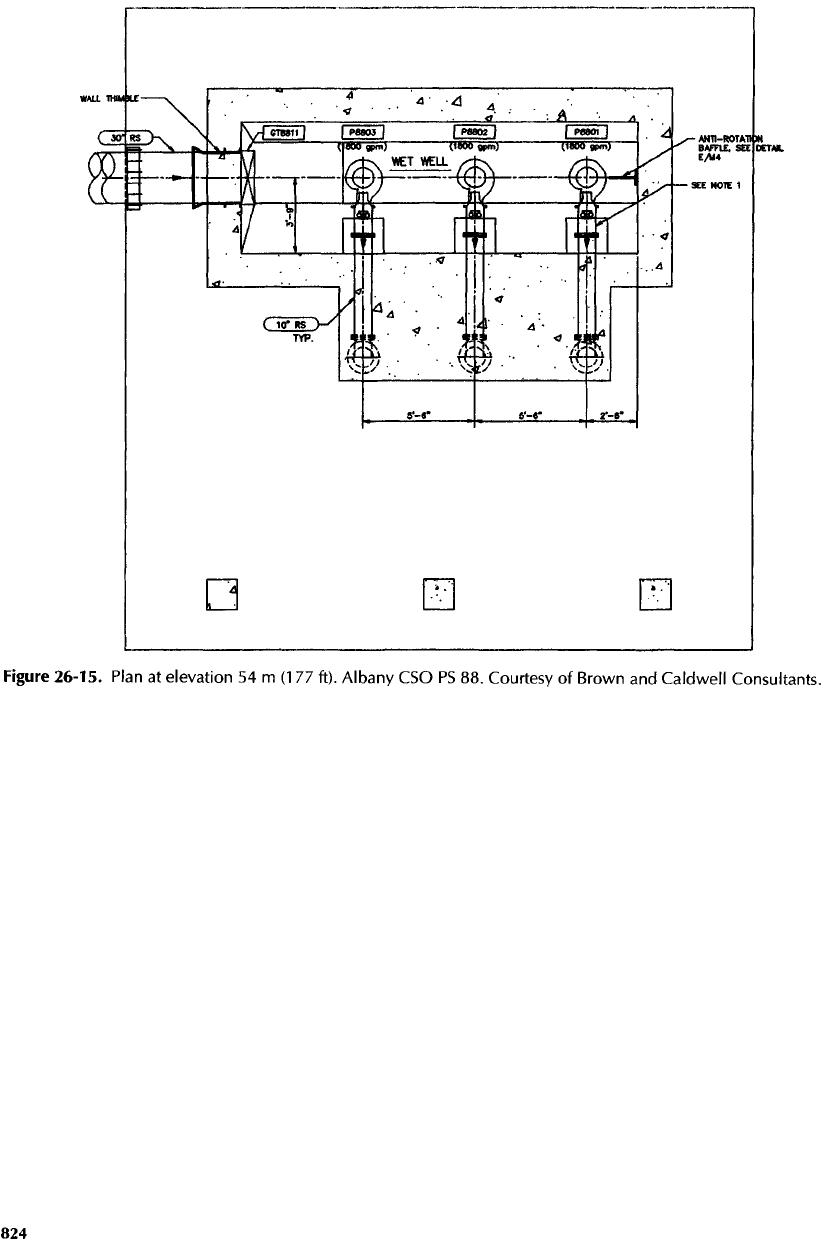
Figure
26-15.
Plan
at
elevation
54 m
(177
ft). Albany
CSO PS 88.
Courtesy
of
Brown
and
Caldwell
Consultants.
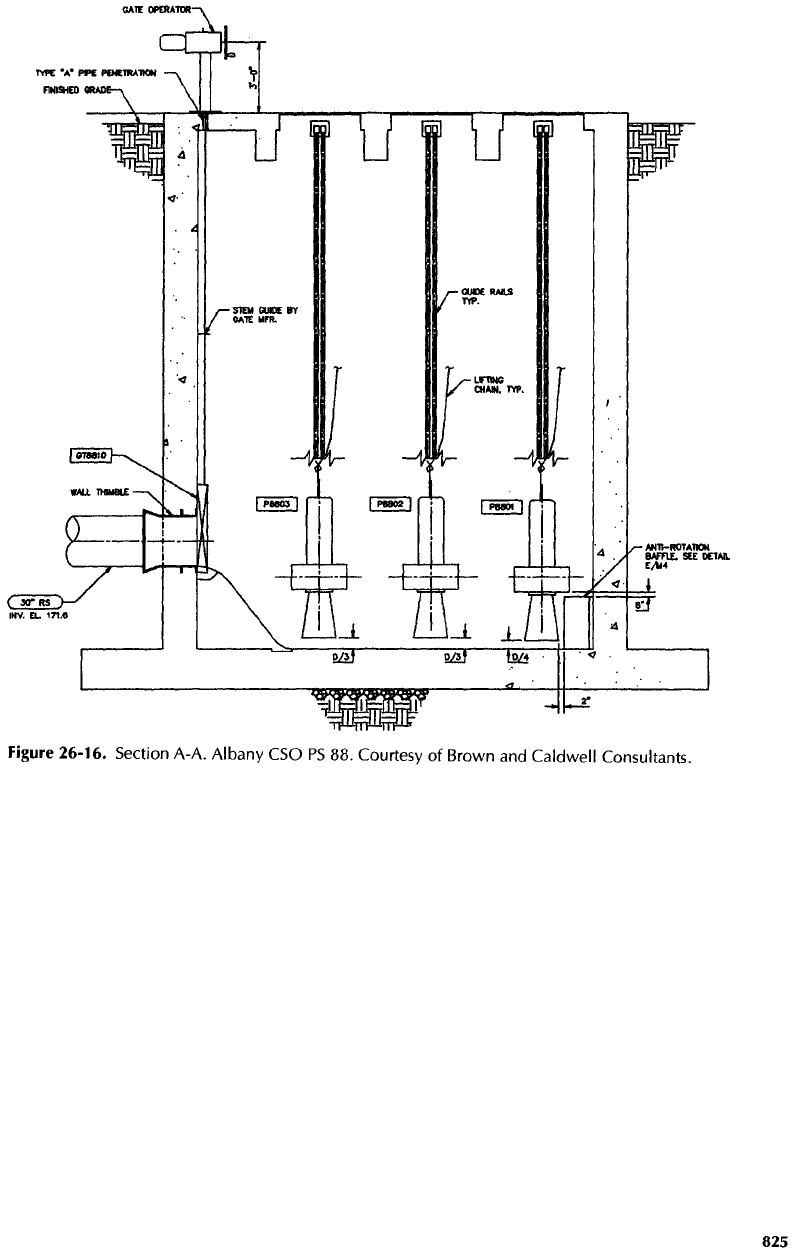
Figure
26-16.
Section A-A. Albany
CSO PS 88.
Courtesy
of
Brown
and
Caldwell
Consultants.
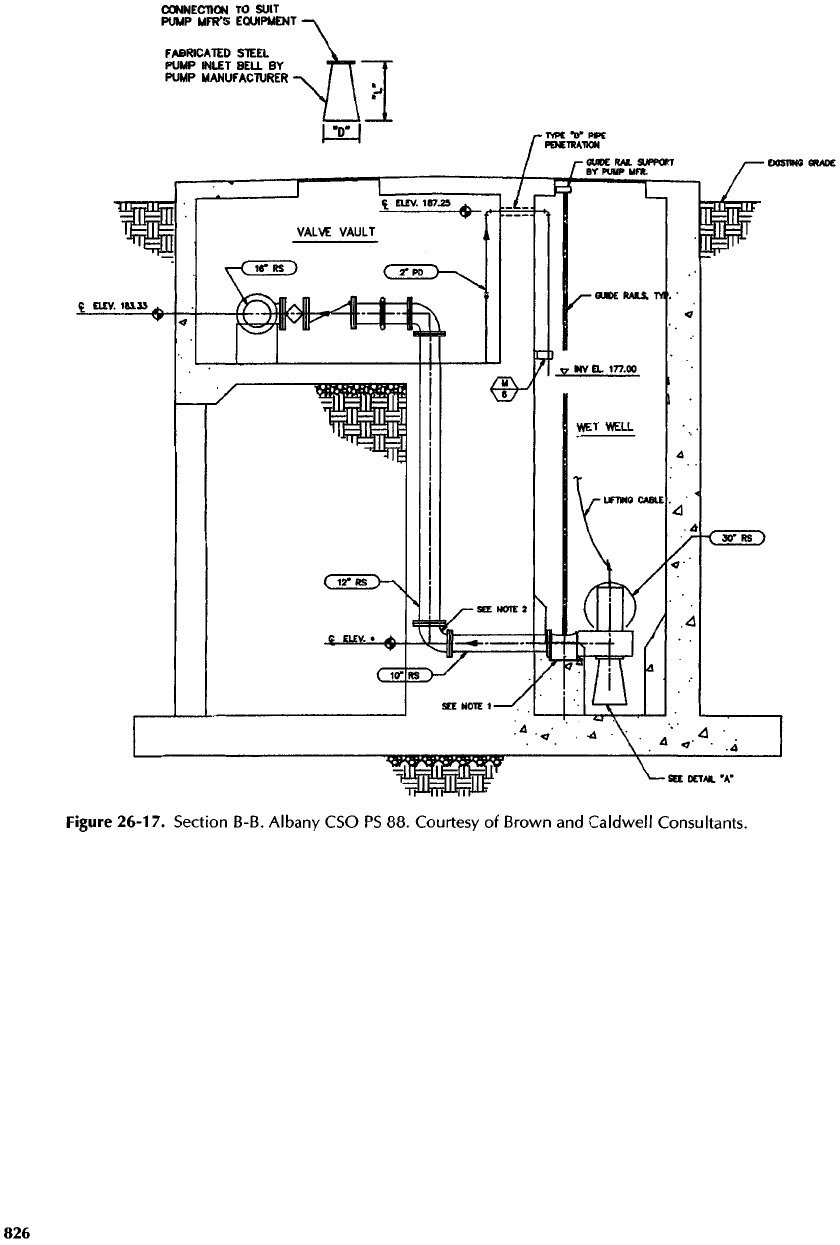
Figure
26-17.
Section B-B. Albany
CSO PS 88.
Courtesy
of
Brown
and
Caldwell
Consultants.
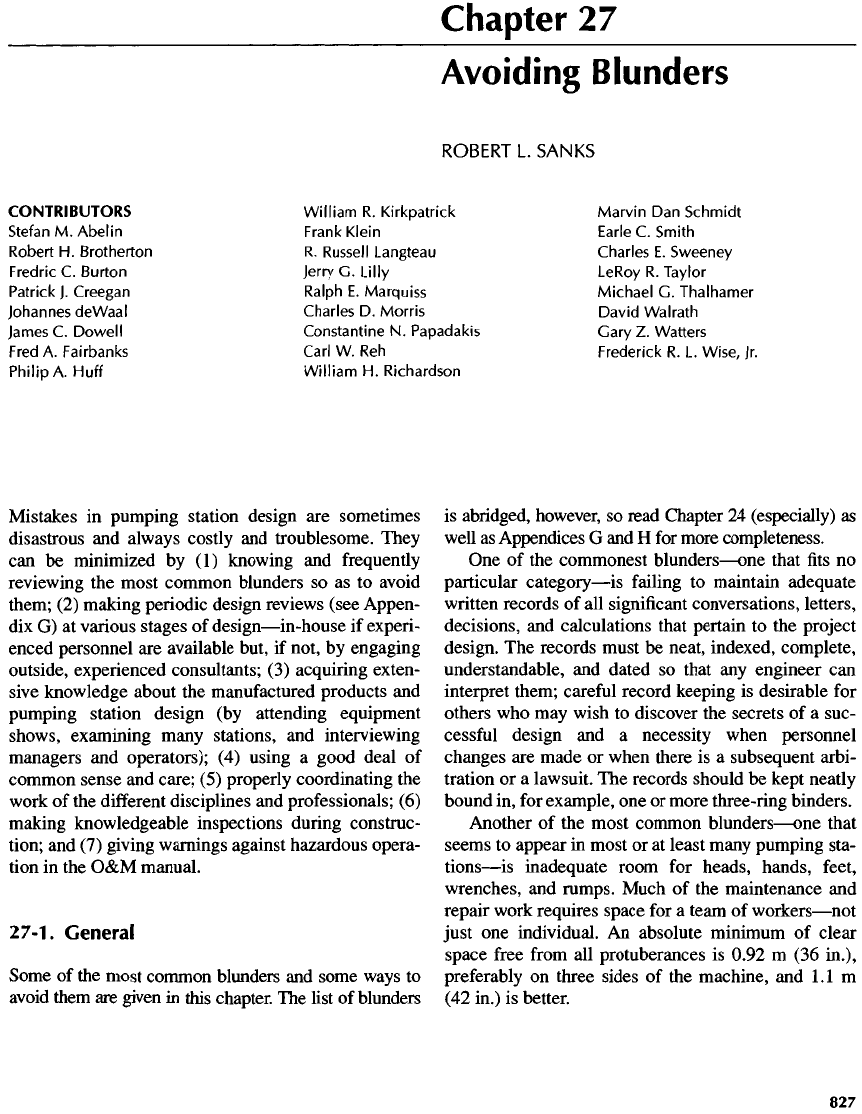
Mistakes
in
pumping station design
are
sometimes
disastrous
and
always costly
and
troublesome. They
can
be
minimized
by (1)
knowing
and
frequently
reviewing
the
most common blunders
so as to
avoid
them;
(2)
making periodic design reviews (see Appen-
dix
G) at
various stages
of
design
—
in-house
if
experi-
enced personnel
are
available but,
if
not,
by
engaging
outside, experienced consultants;
(3)
acquiring exten-
sive
knowledge about
the
manufactured products
and
pumping station design
(by
attending equipment
shows, examining many stations,
and
interviewing
managers
and
operators);
(4)
using
a
good deal
of
common
sense
and
care;
(5)
properly coordinating
the
work
of the
different
disciplines
and
professionals;
(6)
making
knowledgeable inspections during construc-
tion;
and (7)
giving warnings against hazardous opera-
tion
in the O&M
manual.
27-1.
General
Some
of the
most common blunders
and
some
ways
to
avoid
them
are
given
in
this chapter.
The
list
of
blunders
is
abridged, however,
so
read Chapter
24
(especially)
as
well
as
Appendices
G and H for
more completeness.
One of the
commonest
blunders
—
one
that
fits no
particular
category
—
is
failing
to
maintain adequate
written records
of all
significant conversations,
letters,
decisions,
and
calculations that pertain
to the
project
design.
The
records must
be
neat, indexed, complete,
understandable,
and
dated
so
that
any
engineer
can
interpret them;
careful
record keeping
is
desirable
for
others
who may
wish
to
discover
the
secrets
of a
suc-
cessful
design
and a
necessity when personnel
changes
are
made
or
when there
is a
subsequent arbi-
tration
or a
lawsuit.
The
records
should
be
kept neatly
bound
in, for
example,
one or
more three-ring binders.
Another
of the
most common
blunders
—
one
that
seems
to
appear
in
most
or at
least many pumping sta-
tions
—
is
inadequate room
for
heads, hands,
feet,
wrenches,
and
rumps. Much
of the
maintenance
and
repair work requires space
for a
team
of
workers
—
not
just
one
individual.
An
absolute minimum
of
clear
space
free
from
all
protuberances
is
0.92
m
(36
in.),
preferably
on
three sides
of the
machine,
and
l.lm
(42
in.)
is
better.
Chapter
27
Avoiding
Blunders
ROBERT
L.
SANKS
CONTRIBUTORS
William
R.
Kirkpatrick
Marvin
Dan
Schmidt
Stefan
M.
Abelin
Frank
Klein
Earle
C.
Smith
Robert
H.
Brotherton
R.
Russell
Langteau Charles
E.
Sweeney
Fredric
C.
Burton
Jerry
G.
Lilly
LeRoy
R.
Taylor
Patrick
J.
Creegan Ralph
E.
Marquiss
Michael
G.
Thalhamer
Johannes
deWaal Charles
D.
Morris
David
Walrath
James
C.
Dowel
I
Constantine
N.
Papadakis Gary
Z.
Watters
Fred
A.
Fairbanks Carl
W. Reh
Frederick
R. L.
Wise,
Jr.
Philip
A.
Huff
William
H.
Richardson
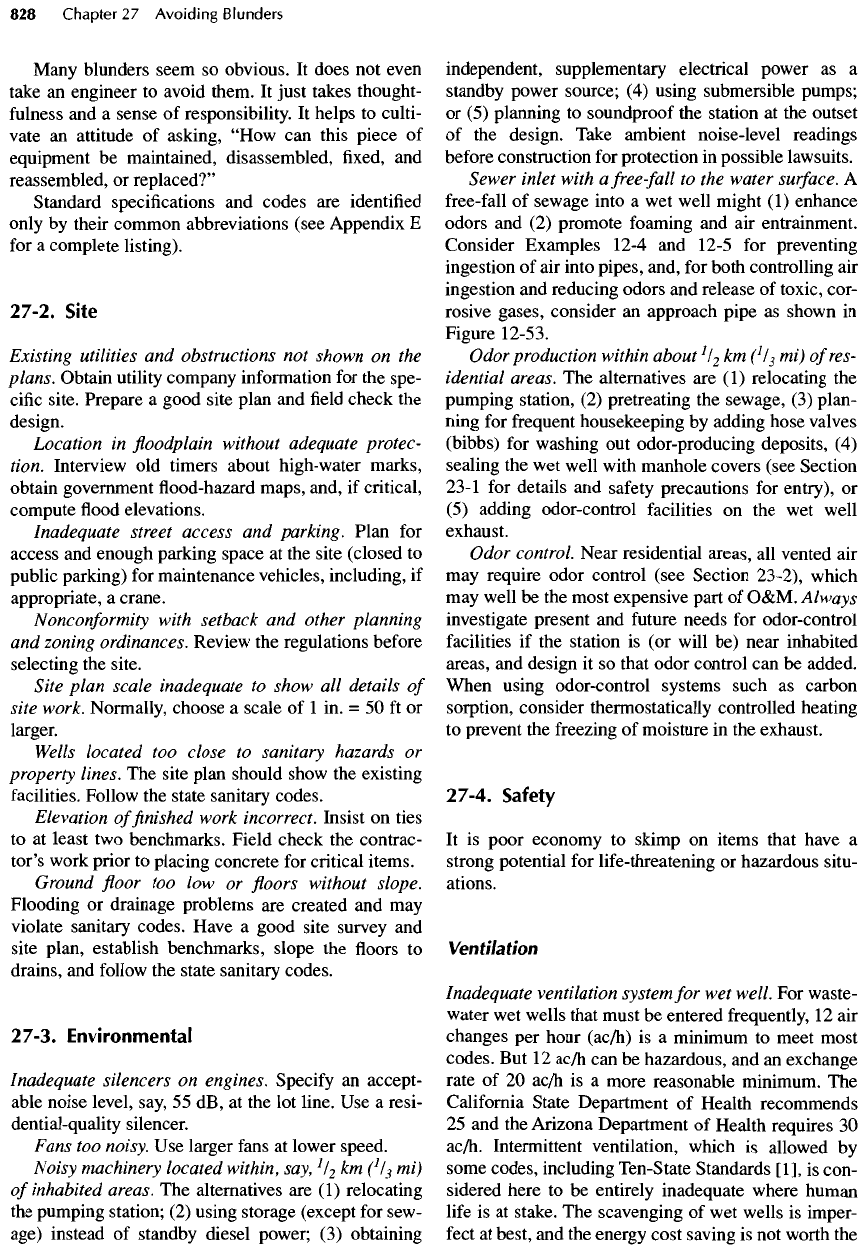
Many
blunders seem
so
obvious.
It
does
not
even
take
an
engineer
to
avoid them.
It
just takes thought-
fulness
and a
sense
of
responsibility.
It
helps
to
culti-
vate
an
attitude
of
asking,
"How
can
this piece
of
equipment
be
maintained, disassembled,
fixed, and
reassembled,
or
replaced?"
Standard specifications
and
codes
are
identified
only
by
their common abbreviations (see Appendix
E
for
a
complete listing).
27-2. Site
Existing
utilities
and
obstructions
not
shown
on the
plans.
Obtain
utility
company information
for the
spe-
cific
site. Prepare
a
good site plan
and field
check
the
design.
Location
in floodplain
without
adequate protec-
tion. Interview
old
timers about
high-
water
marks,
obtain government
flood-hazard
maps, and,
if
critical,
compute
flood
elevations.
Inadequate
street access
and
parking.
Plan
for
access
and
enough parking space
at the
site (closed
to
public
parking)
for
maintenance vehicles, including,
if
appropriate,
a
crane.
Nonconformity
with setback
and
other planning
and
zoning ordinances. Review
the
regulations before
selecting
the
site.
Site
plan
scale inadequate
to
show
all
details
of
site
work. Normally, choose
a
scale
of 1 in. = 50 ft or
larger.
Wells
located
too
close
to
sanitary
hazards
or
property
lines.
The
site plan should show
the
existing
facilities.
Follow
the
state sanitary codes.
Elevation
of finished
work incorrect. Insist
on
ties
to at
least
two
benchmarks.
Field
check
the
contrac-
tor's
work prior
to
placing concrete
for
critical items.
Ground
floor too low or floors
without slope.
Flooding
or
drainage problems
are
created
and may
violate sanitary codes. Have
a
good site survey
and
site
plan, establish benchmarks, slope
the floors to
drains,
and
follow
the
state sanitary
codes.
27-3.
Environmental
Inadequate
silencers
on
engines.
Specify
an
accept-
able noise level, say,
55 dB, at the lot
line.
Use a
resi-
dential-quality silencer.
Fans
too
noisy.
Use
larger
fans
at
lower speed.
Noisy
machinery located within, say,
1
I
2
km
(
1
I
3
mi)
of
inhabited areas.
The
alternatives
are (1)
relocating
the
pumping station;
(2)
using storage (except
for
sew-
age) instead
of
standby diesel power;
(3)
obtaining
independent, supplementary electrical power
as a
standby
power source;
(4)
using submersible pumps;
or (5)
planning
to
soundproof
the
station
at the
outset
of
the
design. Take ambient noise-level readings
before
construction
for
protection
in
possible
lawsuits.
Sewer inlet with
a
free-fall
to the
water
surface.
A
free-fall
of
sewage into
a wet
well might
(1)
enhance
odors
and (2)
promote foaming
and air
entrainment.
Consider Examples 12-4
and
12-5
for
preventing
ingestion
of air
into pipes, and,
for
both controlling
air
ingestion
and
reducing odors
and
release
of
toxic, cor-
rosive gases, consider
an
approach
pipe
as
shown
in
Figure
12-53.
Odor
production within about
1
I
2
km
(
1
I
3
mi)
of
res-
idential
areas.
The
alternatives
are (1)
relocating
the
pumping station,
(2)
pretreating
the
sewage,
(3)
plan-
ning
for
frequent
housekeeping
by
adding hose valves
(bibbs)
for
washing
out
odor-producing deposits,
(4)
sealing
the wet
well with manhole covers (see
Section
23-1
for
details
and
safety
precautions
for
entry),
or
(5)
adding odor-control facilities
on the wet
well
exhaust.
Odor
control. Near residential areas,
all
vented
air
may
require odor control (see Section 23-2), which
may
well
be the
most expensive part
of
O&M. Always
investigate present
and
future
needs
for
odor-control
facilities
if the
station
is (or
will
be)
near inhabited
areas,
and
design
it so
that odor control
can be
added.
When using odor-control systems such
as
carbon
sorption,
consider thermostatically controlled heating
to
prevent
the
freezing
of
moisture
in the
exhaust.
27-4.
Safety
It
is
poor economy
to
skimp
on
items that have
a
strong potential
for
life-threatening
or
hazardous situ-
ations.
Ventilation
Inadequate
ventilation
system
for wet
well.
For
waste-
water
wet
wells that must
be
entered
frequently,
12
air
changes
per
hour
(ac/h)
is a
minimum
to
meet most
codes.
But 12
ac/h
can be
hazardous,
and an
exchange
rate
of 20
ac/h
is a
more reasonable minimum.
The
California State Department
of
Health recommends
25
and the
Arizona Department
of
Health requires
30
ac/h.
Intermittent ventilation, which
is
allowed
by
some codes, including Ten-State Standards [1],
is
con-
sidered here
to be
entirely inadequate where human
life
is at
stake.
The
scavenging
of wet
wells
is
imper-
fect
at
best,
and the
energy cost saving
is not
worth
the
